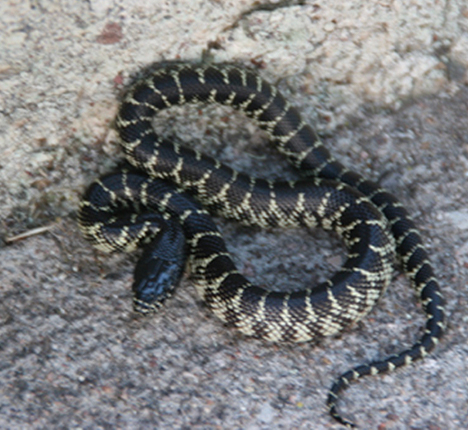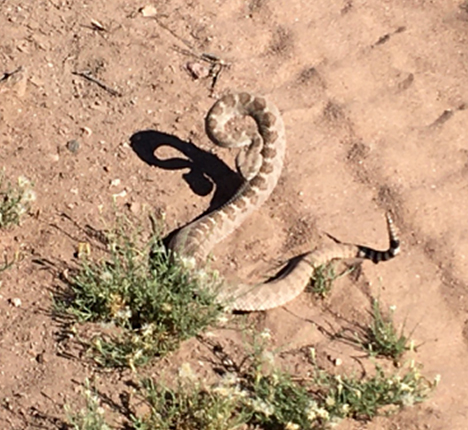Snakes of Pitchfork Ranch
Although we have not found the snake den, legend has it that a government entity dynamited a large rattlesnake den on the Pitchfork, maybe in the late 1940s, early 1950s. Although a neighbor who grew up here doubts it, he is aware of two dens on the ranch. We usually see a dozen or more rattlesnakes a year, although 2020 was a lean year for snakes here. We’ve never killed rattlesnakes, rather we capture them with the “snake-stick” pictured below, remove and relocate. We’ve moved many dozens from around the ranch headquarters. Once we found a young diamondback “ratter” in the kitchen, only to find a second one a day later. And when I removed the second juvenile, I found a third sibling behind the garage.
Melissa Amarello and Jeff Smith have established Advocates for Snake Preservation, https://snakes.ngo, a 501(c)(3) organization that “uses science, education, and advocacy to promote compassionate conservation and coexistence with snakes (and) conduct(s) research…following the guiding principles of compassionate conservation, dispel myths and misinformation about snakes through (their) blog, presentations, and publications, and identify threats to snakes, and provide resources on how we can address those threats.” For a comprehensive snake field guide for Grant County, New Mexico see: https://www.inaturalist.org/guides/11390
There is a peer-reviewed, contending that the Black-tailed Rattlesnake, Crotalus molossus, is not monophyletic, all Blacktails don’t share the same common ancestor. It’s been proposed that the Sierra Madre Occidental uplift beginning in the late Miocene and continuing into the Pliocene split ancestral Blacktails into two species, Western Black-tailed Rattlesnake (Crotalus molossus) and proposed Eastern Blacktail (Crotalus ornatus). The naming of Eastern and Western snakes below is “iffy” as the morphological differences are subtle and beyond our skill-sets, but based on the published differences between them, we appear to have both species here. See the 2012 paper that proposed the “Eastern/Western” distinction here: https://scholarworks.utep.edu/open_etd/2232/
New Mexico burial records of colonial New Mexico show a number of cases in which the cause of death is a rattlesnake bite. Ratters could mean death for cowboys and there were instances where “rattlers, seeking warmth, would move into their bedding and go to sleep. To discourage that, the men often surrounded their blankets with a prickly hair rope, (sisal) laid on the ground. They firmly believed that snakes would avoid slithering over such a rope, since the scratchy bristles tickled their bellies.” As several of the photographs below demonstrate, this rope tactic doesn’t work as Blacktails have twice breached the rope in our outhouse, once to establish residency in the wall until removed.
Despite our initial fears, we have found — just like skunks — these gorgeous animals are easy to lived with. And even though there are an estimated 7,000 to 8,000 venomous snake bites per year in the U.S., snakebite fatalities are rare – maybe fewer than five per year. Yet, those living elsewhere are no to fortunate; in 2919 world-wide, snakebites accounted for about 130,000 deaths and more than 300,000 paralyzing injuries and amputations.

Jeff Smith of Advocates for Snake Preservation re-captures a Coontail that returned to the area under our bird-feeder (patent pending) after an earlier removal. The ratters have figured out that the bird feeder is a good place to hang out, causing us to occasionally find them asleep after a bird-meal and resulting in the flower garden under the feeder being referred to as the “Snake-Garden.” Apparently, after a second removal, they understand they aren’t wanted and seldom return. Melissa maintains they realize the long return haul is not worth the effort, when they’ll just again be relocated. Jeff’s snake stick is far too short for our taste. July 2018

The gorgeous animal is Western Black-tailed Rattlesnake. In 2012, the paper mentioned above proposed splitting Black-tailed Rattlesnakes into two species. It turns out that Blacktails, Crotalus molossus, do not to share one common ancestor. As mentioned, the paper’s authors maintain that the Sierra Madre Occidental uplift split ancestral Black-tailed snakes into two species. The Western and Eastern Black-tailed Rattlesnakes then dispersed northward, maintained their distinct heritage and both snakes appear to be present in Grant County and on the Pitchfork Ranch. Elroy Limmer, September 2020.

We have seen this variety of rattlesnake — Rock Rattlesnake — only twice in our 17-years here. It’s an interesting phenomenon, but we have found that when surprised by happening on a rattlesnake, we recall the snake almost every time we pass by the same area. That is certainly the case with these two sightings. August, 2011

Western Diamond-backed Rattlesnake. After capturing a rattlesnake using our “snake-stick,” we place them in an ice chest or 5-gallon buckets as pictured here, fix the lid atop the container and transport them to the nearest mountain. We do not go over half a mile distant because rattlesnakes are territorial and if removed from its home territory, they get confused, can’t hunt and die. August 2018

Black-Necked Garter-snake, September 2012

Desert Kingsnake, September 2010.

This Black-tailed Rattlesnake and a companion were living in our pump-house where pumps and water for the headquarters are kept. Both were removed, the other in a 5-gallong bucket, this one relocated in an ice chest. August 2019

This Western Diamond-backed Rattlesnake was asleep on the rock wall that surrounds the yard of the headquarters. This photograph illustrates the snake-stick used to capture ratters for removal and relocation. July 2019

Western Diamond-backed Rattlesnake asleep, her engorged upper body making it clear she had just eaten a bird at our bird baths. This is not the first time we have had to relocate ratters, after a bird-meal, asleep at these bird-watering features. It turns out these bird baths have become popular spots for snakes and hawks. July 2020

This Eastern Blacktail breached the rope in our outhouse and took up residence in the wall near the sawdust can. A friend watching the ranch while we we’re away told us he heard a snake rattle while he was in the outhouse. We scoffed, kidded him about being a nervous city-slicker, yet later confirmed his warning, pried the board away from the wall, captured and relocated the rattlesnake. This was the second time a Blacktail has been removed from the outhouse. September 2018

This is the earlier Eastern Black-tailed Rattlesnake that crawled over the type of rope cowboys use to circle their bedrolls. The scratchy bristles of the rope pictured here proved little deterrent as she settled in the cool shade of the outhouse. August, 2016

This Regal Ringneck Snake struck us a poorly named until we realized it was not merely a Ringneck Snake, rather a Regal Ringneck Snake. It has a boring gray top, with this remarkable underbelly and yellow ring, not shown here, around its neck. May 2012

As you can see by the tire tracks, I ran over this Western Diamond-backed Rattlesnake with our four-wheeler vehicle. I returned to see if she survived and you can see that I missed her, although she was irritated and hunkered down, ready for pay-back. May 2020

Western Diamond-backed Rattlesnake. She was irritated and in charge. May 2019

Western Diamond-backed Rattlesnake, August, 2005

Juvenile Lyersnake, which appears to have ingested a rather large meal. May 2015

A beautiful Diamondback, May 2015

Striped Whipsnake, May 2012

Gorgeous Western Black-tailed Rattlesnake, August 2020

Out from the ice chest and into the wild. It has been suggested that this particular Blacktail in neither Eastern nor Western, rather possibly a hybrid. Because both Western and Eastern are abundant, geographically close and commonly overlapping, the fact that their genetic differences are stable with no genetic introgression suggests they make an effort to not interbreed, Why? Interbreeder’s off-springs may be either sterile or have reduced fitness. Otherwise, hybridization would lead to widespread genetic blending of species' ranges. That's not to say that snakes might not occasionally make a mistake in their zeal to reproduce, so hybrids still occur even if mechanisms to avoid them have evolved, as appears to be the case here. August 2019

Despite the plain-to-see beauty of these snakes, there is also a cruel but natural side to their world, apparent to the young Western Diamond-backed Rattlesnake that met its maker here. This video was taken out the kitchen window of a friend who lives near Hillsborough, New Mexico. Melissa of Advocates for Snakes told us the snake that prevailed in this confrontation — the iPhone “videographer” emailed us that “the mortal combat was pretty impressive, and for several minutes of stillness, we couldn’t tell which snake had prevailed” — is a large juvenile or small adult Striped Whipsnake and the decedent is a newborn Western Diamond-backed Rattlesnake, two to six weeks old. This age estimate is certain because the young ratter has only the single rattle segment that they are born with. Melissa, of Advocates, remarked: “filming a snake eating something is rare, as is filming a snake getting eaten, so this video is pretty damn cool.”

